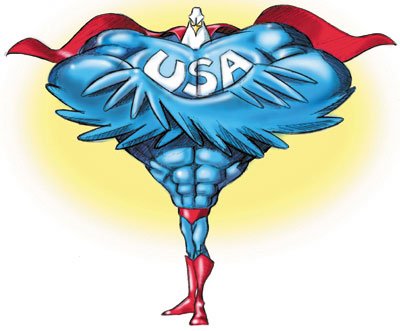How often do you stop to think about what being a citizen of the
United States really means? It’s worth thinking about, and it’s
something to celebrate. Being a citizen of the United States means
you have great freedom and wonderful rights as an individual
person.
How often do you stop to think about what being a citizen of the United States really means? It’s worth thinking about, and it’s something to celebrate. Being a citizen of the United States means you have great freedom and wonderful rights as an individual person. Along with those freedoms and rights, every citizen has responsibilities, such as voting. Here’s a look at the historic documents and the people that shaped our country’s government. Being a good citizen is something you can practice every day. Read on and learn how.
THE PURSUIT OF HAPPINESS
“We hold these truths to be self-evident, that all men are created equal, that they are endowed by their Creator with certain unalienable rights, that among these are life, liberty, and the pursuit of happiness …”
Why do we celebrate the Fourth of July?
It’s the date in 1776 when the Declaration of Independence was approved in Philadelphia.
What made the colonies declare their independence?
The colonies belonged to England and were ruled by the king. But many colonists believed they were being treated unfairly by the king, especially when it came to laws and taxes. In the 1760s, the colonists started to protest their treatment.
By the summer of 1776 the American Revolution had begun. Delegates to the second Continental Congress were meeting in Philadelphia to write our nation’s most famous document. Thomas Jefferson was chosen to write it. John Adams told him, “You can write 10 times better than I can.”
Jefferson, who was from Virginia, wrote the declaration between June 11 and June 28. He rented two small rooms in a private Philadelphia home known today as the Declaration House.
He showed the declaration first to Benjamin Franklin and Adams. They did the first revisions but liked the original writing very much.
Then there was a debate before the Congress. More changes were made, not all of them to Jefferson’s liking. His original document had stronger comments against the king and against slavery.
Once the declaration was approved, the delegates had to sign it. The first to sign – and the largest signature on the document – was John Hancock. It was a very brave thing to do because people who didn’t agree with the British government were considered traitors. King George wanted to hang the traitors. Fifty-five other men also signed the document.
Until that time, the colonists had been fighting for more rights from Britain. Now it became a fight for independence.
THE HISTORY OF OUR PLEDGE
“I pledge allegiance to the flag of the United States of America and to the Republic for which it stands, one Nation under God, indivisible, with liberty and justice for all.”
You probably practice being a citizen every day and don’t even realize it. How? By saying the Pledge of Allegiance. Many students begin the day by saying the pledge.
How did this get started?
Francis Bellamy wrote the Pledge of Allegiance more than 100 years ago. The original pledge stated, “I pledge allegiance to my flag.” In 1923, those words were changed to “the flag of the United States of America.” This change was made so that it would be clear to people who were born in other countries that they were pledging their loyalty to the United States, not their former country.
Another change came in 1954, when Congress added the words “under God” to the pledge. There also have been changes in the way we salute the flag.
Bellamy had suggested a salute with hand and arm extended, pointing at the flag. But in the 1930s and 1940s, a group of Germans called the Nazis began using a similar straight-arm salute to their leader, Adolf Hitler.
In 1942, Congress made the pledge part of the official flag code. They also ordered a new salute – putting the right hand over the heart.
WE THE PEOPLE …
“We the people of the United States, in order to form a more perfect union, establish justice, insure domestic tranquility, provide for the common defense, promote the general welfare and secure the blessings of liberty to ourselves and our posterity, do ordain and establish this Constitution for the United States of America.”
You’ve just read the preamble, or opening statement, to the U.S. Constitution.
Why do we have the Constitution?
The United States has a constitution to protect freedom and to spell out how decisions will be made. More than 200 years ago, our leaders agreed that a Constitution was needed for the United States.
What is a constitution?
A constitution is a statement of basic laws and principles. The U.S. Constitution spells out an agreement, or contract, between the leaders who make decisions and the people they govern. The contract describes what rules the two groups will follow when dealing with each other.
How is the power shared?
When the writers of the Constitution spelled out how the government would work, they put in writing a federal system with three branches of government: executive, legislative and judicial.
– The executive branch is the president, who is elected by the people every four years. The president is also commander in chief of the U.S. military.
– The legislative branch is the Congress, the people elected to make laws.
– The judicial branch is the courts, which decide specific cases.
This three-part system lets the people choose their leader. But it prevents that leader from becoming too powerful.
THE BILL OF RIGHTS
OK, it’s 1789 and the U.S. Constitution provides a great outline for how the new government will work. But not everyone is happy with the document. Four of the 13 states will not approve the Constitution until they are promised more guarantees of individual rights.
That’s why the Bill of Rights was added to the Constitution. The Bill of Rights is what we call the first 10 amendments. These amendments protect our rights and freedoms.
First Amendment: Protects some of our most important rights, including freedom of speech, freedom of religion and freedom of the press.
When you give your opinion about an issue in a class discussion, you are exercising your right to freedom of speech.
When you read the newspaper, you are enjoying the right to a free press. That means the press can choose content without interference by the government.
Second Amendment: Protects the right of citizens to own arms, or guns. Today, there is a lot of controversy about gun control and the Second Amendment.
Third Amendment: States that the government cannot force people to turn over their homes to soldiers.
Fourth Amendment: States that police or government agents cannot enter your home for a search without a special order called a warrant.
Fifth Amendment: Protects you if you ever go to court. First, it states that people are considered innocent of a crime even if they’re accused. They must be proven guilty in court. Second, a person has the right to refuse to answer a question about his or her activities if it might make him or her seem guilty.
Sixth Amendment: Gives everyone the right to a fast and public trial if accused of a crime. A person also has the right to be represented by a lawyer.
Seventh Amendment: States everyone has the right to a trial by a jury.
Eighth Amendment: Makes sure that people who are arrested and go to jail cannot be treated or punished cruelly.
Ninth and 10th amendments: Deal with individual and state rights. People have more rights than the ones listed in the U.S. Constitution and Bill of Rights. And states have the power to offer some additional rights to their citizens.
Other amendments: Since the Bill of Rights was ratified in 1791, 17 more amendments have been added. The most important of these are Amendment 13, which ended slavery; Amendment 19, which allowed women to vote; and Amendment 26, which made the voting age 18. See the complete list at www.archives.gov.











